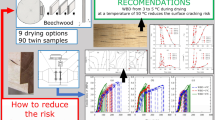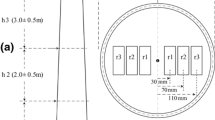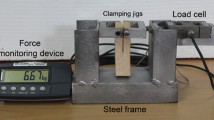Abstract
The detection and analysis of drying-induced stresses in wood are of fundamental importance for quality evaluation and grading of kiln-dried lumber, and thus, various such procedures have been developed commercially. In this paper, a softwood drying-induced stress evaluation concept was proposed that is based on the drying rheology and wood mechano-sorptive mechanism. The evaluation variables for the drying-induced stresses included moisture content gradient (MCG) and mechano-sorptive creep strain gradient (MSCG), both of which are calculated through the lumber thickness. The softwood species needle fir (Abies nephrolepis) was processed into flat-sawn lumber pieces of 40 mm × 120 mm in cross section and was further kiln-dried in conventional laboratory dryers. Width deformation changes along the thickness of lumbers were measured by a slicing method. Shrinkage and elastic and viscoelastic creep strains in the tangential direction were measured quantitatively. Based on the dynamic free shrinkage functions for this softwood species, determined according to small specimen tests, the mechano-sorptive creep strain variables were calculated theoretically. By comparing the mechano-sorptive creep strain differentials between wood surface and its center section, a conspicuous corresponding trend could be revealed between this difference and those of the shrinkage strain differences. A combined variable set, which includes the moisture content differences and mechano-sorptive creep differences between the wood surface and its core section, was proposed based on this research test. The mechano-sorptive creep gradient concept was defined to formulate the drying stress and strain development during conventional drying. After some further mathematical approximations, these newly proposed variables were recommended to estimate the magnitude of drying stress during the mid- and final stages of softwood drying. The effectiveness of this theoretical inference was further verified according to the experimental results of the needle fir drying test.









Similar content being viewed by others
Abbreviations
- A :
-
Material constant, determined based on the physical properties of the wood species
- B :
-
Material constant, determined based on the physical properties of the wood species
- c :
-
Wood center layer
- D :
-
Measured dimension (mm) of the shrinkage specimen
- c η :
-
Viscous coefficient (dimensionless)
- E :
-
Modulus of elasticity (MOE, MPa)
- L :
-
Width of the specimen (mm)
- M :
-
Wood moisture content (%)
- s :
-
Wood surface layer
- T :
-
Temperature (°C)
- t :
-
Times (min)
- x :
-
Coordinate along thickness (mm)
- α :
-
Shrinkage coefficient (1/100%)
- α ve :
-
Correction coefficient (dimensionless)
- ε:
-
Drying strain component
- η:
-
Material viscoelastic coefficients (MPa \(\cdot \) min)
- σ :
-
Drying stress inside the wood (MPa)
- e :
-
Elasticity
- fs:
-
Free shrinkage
- FSP:
-
Fiber saturation point
- ms:
-
Mechano-sorptive
- n = 0–3:
-
Deformation dimensions of the slice specimens
- o :
-
Green state
- s :
-
Kiln-drying state
- N :
-
Shrinkage
- ve:
-
Viscoelasticity
- \(s\dot{ - }c\) :
-
Differences between the surface and center of wood
References
Allegretti O, Ferrari SA (2008) Sensor for direct measurement of internal stress in wood during drying: experimental tests toward industrial application. Dry Technol 26(9):1150–1154
Hanhijarvi A (1998) Deformation properties of finnish spruce and pine wood in tangential and radial directions in association to high temperature drying. Part I: Experimental techniques for conditions simulating the drying process and results on shrinkage, hygrothermal deformation, modulus of elasticity and strength. Holz Roh Werkst 56(6):373–380
Hanhijarvi A (1999) Deformation properties of finnish spruce and pine wood in tangential and radial directions in association to high temperature drying. Part II: Experimental results under constant conditions (visco-elastic creep). Holz Roh Werkst 57(5):365–372
Hanhijarvi A (2000a) Deformation properties of finnish spruce and pine wood in tangential and radial directions in association to high temperature drying. Part III: Experimental results under drying conditions (mechano-sorptive creep). Holz Roh Werkst 58(1–2):63–71
Hanhijarvi A (2000b) Deformation properties of finnish spruce and pine wood in tangential and radial directions in association to high temperature drying. Part IV: Modelling. Holz Roh Werkst 58(4):211–216
Jantawee S, Leelatanon S, Diawanich P, Matan N (2016) A new assessment of internal stress within kiln-dried lumber using a restoring force technique on a half-split specimen. Wood Sci Technol 50(6):1277–1292
Keey RB, Langrish TAG, Walker JCF (1999) Kiln-drying of lumber. Springer series in wood science. Springer, Berlin
Langrish TAG (2013) Comparing continuous and cyclic drying schedules for processing hardwood timber: the importance of mechanosorptive strain. Dry Technol 31(10):1091–1098
Lazarescu C, Avramidis S (2010) Modeling shrinkage response to tensile stresses in wood drying: II. Stress–shrinkage correlation in restrained specimens. Dry Technol 28(2):186–192
Lazarescu C, Avramidis S, Oliveira L (2009) Modeling shrinkage response to tensile stresses in wood drying: I. Shrinkage–moisture interaction in stress-free specimens. Dry Technol 27(11):1183–1191
Lazarescu C, Avramidis S, Oliveira L (2010) Modeling shrinkage response to tensile stresses in wood drying: III. Stress–tensile set correlation in short pieces of lumber. Dry Technol 28(6):745–751
McMillen JM (1955) Drying stresses in red oak. For Prod J 5(2):71–76
Mohssine M, Fortin Y, Fahard M (2007) A global rheological model of wood cantilever as applied to wood drying. Wood Sci Technol 41(3):209–234
Pang S (2000) Modelling of stress development during drying and relief during steaming in Pinus radiate lumber. Dry Technol 18(8):1677–1696
Rice RW, Youngs RL (1990) The mechanism and development of creep during drying of red oak. Holz Roh Werkst 48(2):73–79
Salinas C, Chavez C, Ananias RA, Elustondo D (2015) Unidimensional simulation of drying stress in radiata pine wood. Dry Technol 33(8):996–1005
Sepulveda-Villarroel V, Perez-Peña N, Salinas-Lira C, Salvo-Sepulveda L, Elustondo D, Ananias RA (2016) The development of moisture and strain profiles during predrying of eucalyptus nitens. Dry Technol 34(4):428–436
Tu DY, Gu LB, Liu B, Zhou X (2007) Modeling and on-line measurement of drying stress of Pinus massoniana board. Dry Technol 25(3):441–448
Ugolev BN (1976) General laws of wood deformation and rheological properties of hardwood. Wood Sci Technol 10(3):169–181
Ugolev BN (2005) Wood drying strains. In: Paper presented at the 9th international IUFRO wood drying conference, 23–26 August, Nan Jing, P. R. China, pp 13–23
Ugolev BN (2014) Wood as a natural smart material. Wood Sci Technol 48:553–568
Ugolev BN, Skuratov NV (1992) Stress–strain state of wood at kiln drying. Wood Sci Technol 26(3):209–217
Watanabe K, Kobayashi I, Matsushita I, Saito S, Kuroda N, Noshiro S (2014) Application of near-infrared spectroscopy for evaluation of drying stress on lumber surface: a comparison of artificial neural networks and partial least squares regression. Dry Technol 32(5):590–596
Zhan JF (2007) Bound water diffusion and drying rheology of larch timber during conventional drying (in Chinese). Ph.D. thesis, Northeast Forestry University, Harbin, P. R. China
Zhan JF, Avramidis S (2011a) Mechanosorptive creep of hemlock under conventional drying: I. The determination of free shrinkage strain. Dry Technol 29(7):789–796
Zhan JF, Avramidis S (2011b) Mechanosorptive creep of hemlock under conventional drying: II. Description of actual creep behavior in drying lumber. Dry Technol 29(10):1140–1149
Zhan JF, Avramidis S (2017) Impact of conventional drying and thermal post-treatment on the residual stresses and shape deformations of larch lumber. Dry Technol 35(1):15–24
Zhan JF, Gu JY, Cai YC (2009a) Dynamic visco-elastic characteristics of larch timber during conventional drying process (in Chinese). J Beijing For Univ 31(1):129–134
Zhan JF, Gu JY, Cai YC (2009b) Dynamic mechano-sorptive characteristics of larch timber during conventional drying process (in Chinese). J Beijing For Univ 31(2):108–113
Zhan JF, Gu JY, Shi SQ (2009c) Rheological behavior of larch timber during conventional drying. Dry Technol 27(10):1041–1050
Acknowledgements
This research was financially supported by the Natural Science Foundation of Hei Long-jiang Province, P.R. China (No. C2015053) and the Fundamental Research Funds for the Central Universities of China (Northeast Forestry University, No. DL13CB17), which are gratefully acknowledged.
Author information
Authors and Affiliations
Corresponding author
Rights and permissions
About this article
Cite this article
Zhan, Jf., Avramidis, S. Evaluation strategy of softwood drying stresses during conventional drying: a “mechano-sorptive creep gradient” concept. Wood Sci Technol 51, 1033–1049 (2017). https://doi.org/10.1007/s00226-017-0937-2
Received:
Published:
Issue Date:
DOI: https://doi.org/10.1007/s00226-017-0937-2




